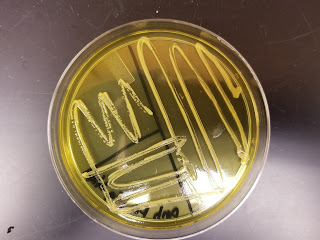The Lactobacillus Hustle

I was completing inhibition assays on my lil' Lactobacilli. I was trying to determine if they could inhibit the growth of a food pathogen like E. coli. So, I got a petri dish filled with MRS agar, dug a well, and inserted 500 microliters of MRS broth inoculated with a 24 hour, undiluted culture of each of the Lactobacillus species, acidophilus, plantarum, and rhamnosus. Then I spread lil E. coli around the top of each of the wells. All the research I read indicated that the two did not make good roomates, but what happened next could not have been anticipated. E. coli just had his run of the place. I asked the Lactobacilli what happened. They informed me that E. coli was nice but could be a little aggressive at times. It was difficult keeping the place tidy while he was around. They suggested that I leave them alone in the well and then bring E coli by in a couple days. So I did. I left them alone in the well before I moved in E. coli. However, I was bamboozled! Lil' L...


